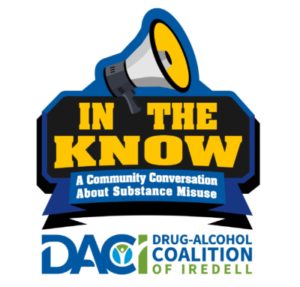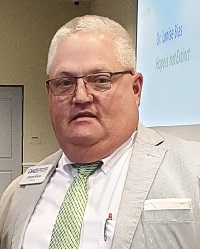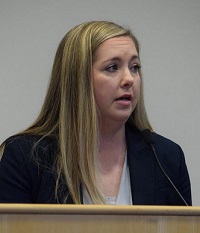
Editor’s Note: This is the first part of a three-part series on Drug-Alcohol Coalition Iredell’s recent “In the Know” event.
BY DEBBIE PAGE
All the data suggests that substance misuse in Iredell County is trending in the wrong direction.

Outlining the task before the Drug-Alcohol Coalition of Iredell — and the community — for about 120 attendees at DACI’s recent “In the Know” community event, Director Shane Nixon said the reality is a “scary” one for all concerned.
“If you look at drug and alcohol misuse over time, the line that we graph for that statistic is going straight up,” he said. “All the work I do in my lifetime, and even all the work you do in your lifetimes — all that good work — will not change the trajectory of that line. What we can hope to do is to flatten that line some.”
Though the fear of the substance misuse situation is real and sometimes overwhelming, Nixon said, progress can be made. That progress begins with understanding what is happening across the county and educating the public about this crisis.
“My hope is that you will take the information we have and go away from this place in a more positive direction,” Nixon said.
IREDELL EMS DEEPLY IMPACTED BY SUBSTANCE MISUSE
Iredell County Emergency Medical Services Director Blair Richey said the goal of EMS paramedics, EMTs and peer support specialists is to treat all patients with respect as they deal with the crisis situations. They endeavor to build trust, understanding, and relationships with the community members that they serve.
Iredell County EMS responds to about 20,000 calls per year. In 2018, they handled 552 drug or alcohol related incidents. By 2022, the number had jumped to 1,842 calls, an average of five per day.

“Calls related to drugs increased 158 percent, calls relating to alcohol use rose 347 percent, and calls with both drugs and alcohol present went up 111 percent,” Richey said.
Because the types of drugs EMS personnel encounter are constantly evolving, they must continuously adapt and focus continuing education sessions on these new substance use dangers as they emerge.
Most overdoses are opioid-related, with some victims not even aware they had ingested an opioid because the marijuana or pill they ingested was laced with it without their knowledge, Richey explained.
Iredell County has been flooded with counterfeits of commonly abused medications such as Ritalin, Aderall, Concerta, Xanax, Percocet, Vicodin, Valium, and Oxycontin, she said.
Richey has been fooled herself when comparing the real medication with the counterfeit drugs.
Frighteningly, these widely available drugs, often marketed to teens through social media, are often laced with the powerful opioid fentanyl — which is 100 times stronger than morphine and 50 times stronger than heroin — or with highly addictive methamphetamine.
In 2021, Richey said the federal Drug Enforcement Agency seized 20 million fake pills. In 2022, the number increased to a staggering 50.6 million.
Because these pills are increasing in strength and toxicity, EMS must stay up-to-date on trends, looking for meth lab evidence and getting trained on how to handle proximity to the highly deadly fentanyl, which can be deadly if touched or accidentally inhaled by EMS staff.
In 2019, EMS used grant funds to create the Community Response Support Team (CRST), made up of peer support specialists and paramedics, to maximize resources and provide community-based care to those who overdose, have a substance use disorder (SUD) or alcohol use disorder (AUD), or have chronic diseases, especially for the medically underserved in the county.
Community paramedics follow up after chronic disease or fall calls to help with illness management, any needed resources, stable medical care options, and disease/injury prevention help.
Peer support specialists follow up with all SUD/AUD calls to offer resources, treatment options, Narcan, and connections to housing, primary care doctors, food assistance, or any other needs.
“We meet them where they are,” said Richey.
The peer support staff also offer a medical assisted treatment “bridge” option (suboxone) to those seeking recovery and treatment to help them stay clean until their appointment or rehabilitation stint can be arranged.
“Most of these people are in crisis and need immediate help,” said Richey.
The EMS programs have helped county employees with problems as well as community members. “Substance use affects all of us,” added Richey. “Addiction and mental illness do not discriminate.”
In 2022, EMS and the CRST assisted 223 families affected by SUD/AUD, helped 84 individuals get into treatment programs, made 537 referrals to get other support services, and gave out 520 Narcan kits to help prevent opioid overdose.
SCHOOLS ALSO AFFECTED BY SUBSTANCE USE
Local schools are not immune to the rising substance use disorder or alcohol use disorder.
Iredell-Statesville Schools Chief of Strategic Planning and Students Boen Nutting said the district serves 21,000 students in 38 schools, including five high schools and three early colleges. Some of these students have mental health and behavioral issues that too often lead to substance or alcohol use.
In the past school year, student referrals to the office reached 14,581, with 7,448 occurring through January of this school year. The district has a strategic plan to constantly review these numbers and implement strategies to reduce behavior issues.
In the 2021-22 school year, vaping was the most prevalent substance-related issue. Now in her 30th year in education, Nutting said, “We have never seen anything quite like it. The vaping has just been of epic proportions, and we have worked really hard to try to find out how to stop that.”
The district is frequently revising it vaping policy to keep up with the changes in devices and substances used in them.
In 2021-2022, the district had 417 non-tobacco vaping referrals, with 230 so far this year. Vaping THC or other cannabinoids is becoming a serious issue because of the substance’s addictive qualities. “We are developing programs to help as well as preventative pieces too.”
This year the district also began tracking cannabinoids and Delta 8 incidents, with eight referrals so far. Delta 8, an improved form of THC (the chemical found in the marijuana family), can be consumed in a vape or as an edible and induces a high similar to moderate marijuana exposure.
Possession of controlled substance incidents reached 112 last year, with 67 of those involving marijuana. So far this school year, 58 students had controlled substances on campus, with 34 involving marijuana.
During the last school year, 18 students were under the influence of alcohol at school, with five reported so far this school year.
Nutting said the district had four cases of drug distribution last year, with three so far this school year.
Nutting also recounted a middle school incident where a student brought THC gummies, resulting in eight students requiring medical treatment by EMS and hospitals.
The district offers help for substance misuse in schools through the Student Assistance Program counselor at each school as well as the district’s 24 nurses and 10 social workers.
The district also just received a $17 million mental health grant to provide crisis assistance on campuses, including adding 22 clinicians on campuses to provide mental health or SUD assistance.
Children’s Hope Alliance also provides mental health services to students with grave mental health or SUD problems.
Mooresville Graded School District Chief Communications Officer Tanae Sump-McLean said MGSD serves 6,000 students in seven schools and a Mi-Waye alternative education program.
“Our concern, much like I-SS, is on vaping,” said McLean.
The system began tracking vaping in 2018-2019, recording 102 use or possession incidents in middle and high school. Because of COVID pandemic related closures, statistics for 2019-20 and 2020-2021 were incomplete.
This year so far, McLean said the district had 92 referrals, with nearly four months of school left, so numbers are on the rise. Three of these cases were in a K-3 school, and prevention programs normally do not start until fifth grade.
The number of tobacco incidents was at 100 in 2018-2019 and has fallen to just six this year as students shift to vaping nicotine products. Traditional marijuana referrals have also fallen to three this year.
Vaping is a real problem for schools because of easy access to the paraphernalia at the many vape stores in the community and the marketing of vapes as a “safe” alternative to tobacco. Further concerns emerge because students do not really know what is in the vaping liquids they ingest.
These vaping liquids do affect students’ developing lungs and are often laced with harmful chemicals or even dangerous substances.
“We have had to call 911 twice at Mooresville High School because of something students had in their vape and said they were not aware of what was in it,” McLean said.
MGSD has a number of initiatives to address substance misuse in schools. Fifth-graders begin awareness and prevention with the DARE program. The high school has K9 Bella, who sniffs for illegal substances around the school.
The school system also has a random suspicionless drug testing policy of all high school students participating in any extracurricular activity, but parents can opt their child into the testing program even if they do not participate in extracurriculars.
McLean said the emphasis is getting those students who test positive into treatment and good health. After going through a program, students can return to their extracurricular activities.
The district has also installed vaping detectors in all school restrooms and instituted the P3 reporting system that allows students to anonymously share their concerns with staff and get help to others.
MGSD is also partnering this semester with DACI to provide SUD/AUD awareness programs for staff and students. As soon as Iredell County Health Department staff’s certification is complete, the district will also implement the “Catch My Breath” anti-vaping program for fifth through 12th grades.
“We still need the support of the community to emphasize the dangers of vaping to our K-5 students and to emphasize that vapes are not healthy and that students should not possess them.”
McLean also applauded the important work to assist students done by the district’s outstanding school counselors and school nurses at each campus.
Coming Soon
♦ Part II: Narcotics stats from the Iredell County Sheriff’s Office, new illicit drug dangers, the poverty and SUD/AUD connection, and legal system impacts.
♦ Part III: “Hope is Not Extinct,” an inspiring message to encourage the community to action in battling substance misuse, by Dr. Lonise Bias, mother of University of Maryland basketball great Len Bias, a two-time ACC Player of the Year and All-American who died of a cocaine overdose in 1986.



